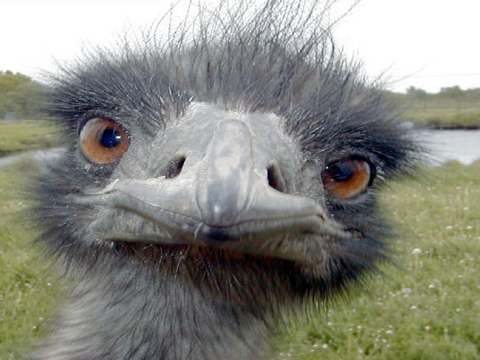As we become more conscious of where food comes from, a growing number of people, disgusted by the cruelty of CAFOs and unconvinced by supermarkets, are getting to grips with rearing their own livestock. ‘It puts people in control,’ says David Morris, co-founder of the New Landowner smallholding consultancy. ‘They know exactly how their animals are being kept and fed. Intensively farmed animals are fed cheap rubbish because supermarkets have forced down the cost and subsequently farmers have to make cuts.' This is why Morris set up his consultancy 12 years ago to give people the advice and support they need to start their smallholding. ‘There is a market for this sustainable option,’ he adds. ‘Home reared animals have a better quality of life and will go on producing for much longer.'
Keeping chickens has long been popular as a gentle introduction to smallholding but there is a huge variety of animals that shouldn’t be overlooked. Livestock can be kept for food, clothing or company, and with proper management, smallholders can reap the rewards. But Richard Storer, owner of Baylham House Rare Breeds Farm warns that there are considerations to be made before purchasing animals. ‘Firstly decide whether or not you can eat the progeny. If you can’t, don’t breed from your stock. If you are going to use them for meat, find out about local abattoirs and ensure your choice works to a standard in accordance with current animal welfare legislation.' It’s also a question of taste. Once people have enjoyed the fruits of their labour they’ll rarely go back to manufactured produce according to Morris who notes that ‘people running successful smallholdings can make a living from selling on their surplus products.’ Plus, you don’t need acres of land or experience to get started. There are options to suit your land and your budget. Intrigued? We’ve got the lowdown on all you need to know.
A is for alpaca
These sturdy camelids produce sought after wool that can be used for clothing, rugs, duvets and soft furnishings. Handling alpacas may take some getting used to but there is plenty of support and advice available from the British Alpaca Society. ‘These animals are great,’ says Shirley Bettinson from Toft Alpacas. ‘They produce luxury fibre all year round and they have very soft pads so don’t churn up the land like cows do.'
 B is for bees
B is for bees
Not only do they produce delicious honey, the pollination services they provide are vital for food production. ‘Beekeeping is great for the environment,’ says Heidi Herrmann, from the Natural Bee Keeping Trust. 'A healthy eco-system needs bees and vice versa. It is our responsibility to restore the natural environment to a healthy one for bees.' What’s more, according to Tim Lovett from the British Beekeepers Association, beekeeping is not difficult. 'Yes you will get stung, but with proper management and positioning of hives bees can be kept in most town gardens.' A starter colony will cost up to £150 but Lovett suggests getting in touch with your local beekeeping association as they may be able to provide a swarm for free.
C is for commitment
Keeping livestock is a 365 day-a-year occupation. ‘It is only by observing your stock carefully on a daily basis that you’ll be able to spot a change in behaviour – often the indication of a problem,’ warns Storer. He suggests getting involved in lambing or calving at a local farm to get some experience prior to taking on stock. ‘Establish as many local contacts as you can – the farming industry is usually willing to help neighbours in a crisis.’
D is for dog
Man’s best friend and the most loyal of companions, dogs are also great for securing, protecting and managing your stock. Working dogs, such as Border Collies, German Shepherds and Belgian Malinois are not bred to look handsome but for purpose and function. The Kennel Club has an exhaustive list of stock-friendly breeds.
 E is for emu
E is for emu
Although rare in the UK, keeping emus is common in other countries including the USA. Margaret Dover has been breeding emus for 16 years at Leicestershire Emus and Rheas. She says nothing is wasted when farming this versatile bird. ‘They produce eggs and meat to eat, and the skins and feathers are also used. Emu oil is an excellent moisturiser.'
F is for fencing
Good fences are essential to the success of a smallholding. Your chosen stock will determine what type of fencing to erect but whether it’s a small pen you need, or a fully fenced paddock, you need to know that your animals are safe and secure. Try Riach Contracting Fencing Services for planet-friendly pens.
G is for goats
Easier to keep and less space hungry than cattle, goat’s milk is an increasingly popular alternative to cow’s milk and the whole family can enjoy bottle feeding the kids. In fact, worldwide, more people drink their milk than the bovine option. The British Alpine breed is a good choice and produces plenty of milk.
H is for hay
This mix of grasses is a primary food source for many animals including cattle, horses, goats, sheep and rabbits. It's cheap, sustainable and totally organic, and with careful storage (if it gets damp it will rot quickly) will provide nourishing fodder for stock throughout the harsh winter months. Watch out for poor quality hay though. This will be dry, bleached out and coarse-stemmed.
I is for incubator
If you want to hatch chicks you’ve got to create the right conditions. Eggs need to be kept at a consistent temperature and this is where the incubator comes in. It’s a delicate process that needs to be thoroughly explored. The Incubator Shop offers a comprehensive step-by-step guide to making the most of yours.
J is for Jersey cow
If you’re going to keep cows then the Jersey cow is top of the range with their good looks, petite size and delicious creamy milk. They are also the most eco-friendly of the dairies: ‘Recent research shows Jerseys require fewer resources than other cows because they produce more milk from eating the same amount of grass as other breeds,' boasts DairyCo’s Kevin Beaty.
 K is for Kunekune pigs
K is for Kunekune pigs
This rare breed of pig originates from New Zealand where they were kept for meat by the Maoris. Once close to extinction, Kunes are steadily being introduced into other parts of the world by people eager to see the breed survive. If reared outdoors, they can be used for meat at approximately nine to 12 months, or with their easy-going temperament and gentle character, you might prefer to keep them as natural lawnmowers. Their foraging habits can also help regenerate your land.
L is for llama
These gentle giants are used for both their milk and their wool. They have a double fleece consisting of an outer guard hair and a soft undercoat that can be used to create super soft yarn. They are good team members, protecting their group from predators and will live in harmony with other field stock such as ponies.
M is for manure
Smelly but a brilliant fertiliser, horse and cow manure is frequently used on farms and gardens. According to Online Manure, using it as a fertiliser has a double benefit for the environment. As well as being a natural nutrient for plants, using manure prevents it ending up in landfill where noxious gasses build up creating harmful emissions.
N is for North Ronaldsay Sheep
The rare breed North Ronaldsay evolved in a specialised seashore environment on their native island, but have adapted well to mainland managements according to Anne Lane from the North Ronaldsay Sheep Fellowship. ‘Their wool produces a variety of colours making it popular with hand-spinners, felters, knitters and textile designers,' she adds.
O is for ostrich
These big birds can be reared for meat and produce by-products including oil and feathers. According to the British Domesticated Ostrich Association (BDOA) ostriches have the potential to be more feed-efficient than pigs or poultry. The BDOA also notes that world demand for protein will be 50 per cent higher in 2025 than today, and that ostriches can meet this more efficiently than many other livestock.
P is for pasture
The type of pasture you have will determine your choice of livestock. ‘Some breeds will need good quality grass and plenty of it. If your pasture does not provide such luxury you are better off choosing a breed which will do well on limited quality grazing – many rare breeds fall into this category,’ says Storer. ‘In an ideal world you should aim to keep your stock off your pasture in alternate years thus reducing your worm burden.’
Q is for quail
Small, cute and easy to keep quails are perfect for the garden. According to OMLET, quails are ideal for people with little time on their hands - they simply need a run, food, water and bedding checks. Their eggs are incredibly good for you too and are an enriched source of antioxidants, essential fatty acids and vitamin B riboflavin.
R is for research
Before purchasing any livestock, thorough research needs to be carried out. Storer suggests visiting local livestock breeders and establishing a shortlist of breeds you may be interested in before weighing up the pros and cons. The Rare Breeds Survival Trust website provides details of various breed societies to contact for advice and information.
S is for silkworms
The Chinese have been producing silk from these worms for the past 3000 years. As the worms mature they spin a fat, soft, creamy white cocoon, made from one continuous thread of fluid silk around themselves. There are two methods of producing silk, one of which does not kill the pupa. Once the moth has emerged and broken the thread, the cocoon can be soaked in boiling water and the strands unwound.
 T is for thoroughbred
T is for thoroughbred
Utilising the unique skills of rare breeds of horses and ponies is the most appropriate way to increase their numbers according to the Rare Breeds Survival Trust. Breeds such as the Dales and Fell ponies and Cleveland Bays are popular for driving, logging and spinning, although if it’s speed you want, nothing beats the British Thoroughbred. Also getting about by horse is an eco-friendly mode of transport.
U is for udder care
Whatever your dairy animal of choice, caring for their udders is as vital as caring for the animal itself. Udders are prone to bacteria on the surface so using a pre-dip prior to milking will help prevent mastitis. Udder salve is a water repellent soothing and healing balm that helps heal chaps and sores and maintain suppleness of the teat skin. At the first sign of infection contact your vet.
V is for vermin
There are many forms of vermin control available. The most natural option is to get a cat but if you weren’t planning on getting a pet, then there are plenty of feral cats around that make excellent hunters. Ask local farmers if they have any surplus they want taking off their hands, while the Cat Protection League will neuter and vaccinate feral cats for free in most parts of the UK.
W is for winter housing
Animals feel the cold too so it’s important to make proper provisions for them duriing the winter months. Housing can be anything from a cosy hutch for rabbits to a full-sized barn for cattle. The Department for Environment Food and Rural Affairs (DEFRA) has guidelines on specific animal housing requirements.
X is for x marks the spot
The spot being the point where an identification tag should sit. According to UK law, many animals including cattle, sheep, goats, pigs and deer must have such a tag and new keepers of these animals need to register for a County Parish Holding (CPH) number. Owners of camelids, including alpacas and llamas, do not currently need to have identification for their animals but up-to-date requirements are available from DEFRA.
Y is for yak
Originally from the high Tibetan Plateau, these bison like bovines are often domesticated and used as transport animals. Their very long coats consist of long coarse hairs on top and an undercoat of soft silky wool that can be used in a variety of textiles.
Z is for zoonotic diseases
These are diseases that can be spread (or shared) between animals and humans. Examples include bovine tuberculosis, avian influenza, ringworm and anthrax. The Health Protection Agency can inform and advise on how to avoid these nasty bugs and it's always worth asking your local vet which vaccines they recommend for your livestock.
| READ MORE... | |
 |
GREEN LIVING How to handle the hosepipe ban: everything you ever wanted to know Despite the spring downpours, a hosepipe ban is already in force thanks to drought. It’s time to rethink how we use water in the garden, says author Michael Littlewood |
 |
GREEN LIVING Top 10... organic seed suppliers As the weather heats up, gardeners’ thoughts are turning towards seeds. We round up the top spots to pick up organic, ethically produced seeds |
 |
GREEN LIVING Smallholding: the basics From sheep to spinach, Gervase Poulden has the skinny on how to make your smallholding dreams a reality |
 |
GREEN LIVING Why bees & biodiversity benefit from indigenous wildflowers Filling your garden with wildflowers helps honeybees and butterflies, and creates a relaxed mood. And, from the Easton Walled Garden to Sissinghurst, there's plenty of inspiration |
 |
GREEN LIVING The A to Z of beekeeping From zoning to killer bees and lovely honey: Gervase Poulden explains the essentials of beekeeping |








